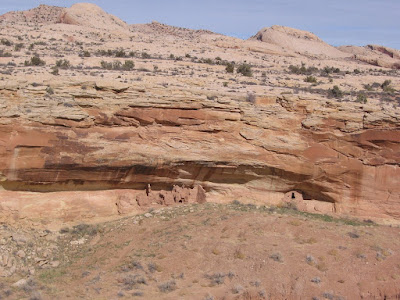The first part of the trail is a 4WD road that ends on slick rock at the edge of the wash. The Wolfman Petroglyph trail is one of the better known trails in an otherwise unpublicized area that has many small archaeology sites in a very rugged and scenic setting. There is a BLM sign in box and information kiosk at the trail head, but the information was not specific for this trail.
 From the trail head, the La Sal Mountains are visible to the north and there are steep sandstone cliffs along the east side of the Butler Wash valley. There are a few rock cairns where the 4WD road ends leading to the south to a narrow notch that leads to a ramp down into the wash bottom.
From the trail head, the La Sal Mountains are visible to the north and there are steep sandstone cliffs along the east side of the Butler Wash valley. There are a few rock cairns where the 4WD road ends leading to the south to a narrow notch that leads to a ramp down into the wash bottom.From the rim there is a small ruins site slightly to the north that is probably most easily viewed from this elevated position.
At the bottom of the rocky ramp an alcove comes into view and the panel is just past the alcove. These figures are to the far right seem to be much smoother and carefully done than others in the region.
The bird figure next to the humanoid looks like an Avocet, or some other long billed shore bird and further to the left looks like a Great Blue Heron. These are wetlands birds that might be common in the bottoms of the nearby San Juan River. There are two carefully done canine prints and other figures appear to be flowers or parts of plants. One figure looks like Cattail, a common wetlands plant.

Closer to the alcove is another group of figures that includes what looks like an owl head, a fish skeleton, a catfish, and a jelly fish. The circular figure looks like an overhead view of a mushroom. It seems to have also drawn attention as a target. Many of the petroglyph panels in the region feature wildlife, but mountain sheep seem to be the most common.



No comments:
Post a Comment